
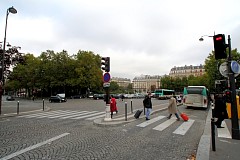
|
|
After visiting Versailles I took the RER back to Paris and then rode the Metro from
St. Michel to the Denifert-Rochereau stop to visit the catacombs. When you reach street
level you just have to follow the signs - it's not far. I am near Red-Square-11 on the map.
|
|
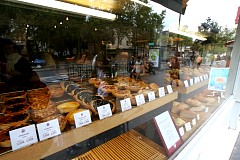
A bakery along the way - I like that you can see both people in the shop and reflected
pedestrian traffic.
Catacombs
represent indeed only an eight-hundredth of all the galleries under Paris.
The underground quarries spread under the 5th, 6th, 8th,
12th, 13th, 14th, 15th, 16th and 20th districts of Paris. The most extended network are located under
the 5th, 6th and 14th districts.
|
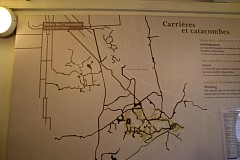
Above the door outside the entryway to the catacombs are the words
(in French): "Stop! This is the empire of death."
In the entrance is also this map. Since the time of the Romans the
limestone formations under Paris have been quarried. There are at
least 185 miles of tunnels in the entire network of catacombs. Only
this very short length (about 1/2 a mile) of the catacombs I am entering is open to the
public.
Among a certain Paris
subculture, exploring the forbidden area of the quarries is considered a sport.
Despite the best efforts of maintenance workers to seal off illicit
entrances and police patrols that slap heavy fines on trespassers,
the maze of tunnels is so extensive that it is simply not possible
to keep ahead of the cataphiles (those who love catacombs).
|
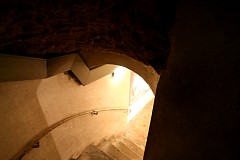
Paris sits atop a maze of enormous gypsum and limestone quarries that were mined
beginning in the 12th century for the construction of Notre Dame, the Louvre, and other buildings.
Created haphazardly beneath the surface city, these quarries became increasingly unstable over time.
When a street collapsed in 1774, Parisian authorities investigated the galleries and reinforced
weak areas. As they did, the investigators marked the tunnel walls with the names of the corresponding
above-ground streets. These two-century-old signs are still used for navigation.
The freshly mapped underworld would soon have many uses.
I am now descending sixty-odd feet below the surface of Paris.
|
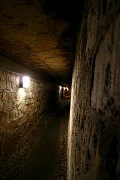
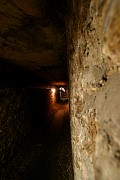
I was told flash photography is not allowed. Apparently the light aids bacterial growth,
and none of us wants that. I took these shots by holding the camera flat against the
wall and holding the lens open long enough to collect enough light. Consequently,
you get a better perspective on what it's like to walk down the tunnel. There is
crunchy gravel underneath. It's about 52 degrees Fahrenheit here all year long.
It's also very clean.
My unanswered question is why the catacombs are so far underground. I would think
a limestone quarry would start at ground level and be dug down from there. Is it
really 60 feet down until you reach limestone? I would expect lots of big, deep pits,
not galleries like a gold mine.
|
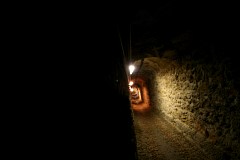
Note there is no timber bracing needed to hold up the ceiling.
Most of all of Paris' larger churches once had their own cemeteries, but city growth and
generations of dead began to overwhelm them. From the late seventeenth century, Paris'
largest Les Innocents cemetery (near the Les Halles district in the middle of the city)
was saturated to a point where its neighbors were suffering from disease, due to
contamination caused by improper burials, open mass graves, and earth charged with
decomposing organic matter.
After almost a century of ineffective decrees condemning the cemetery, it was finally
decided to create three new large-scale suburban cemeteries and to condemn all
existing within the city limits; the remains of all condemned cemeteries would be
moved discreetly to a renovated section of Paris' abandoned quarries.
|

Everyone takes this picture located where the bones first appear. These skulls
are cemented in place for shock value. Boo.
From 1785 until the 1880s the
catacombs received the bones of an estimated six million Parisians.
At the time the catacombs were at the outskirts of town.
No attempt was made to identify or
separate individual bodies, but each set of bones was marked with a plaque signifying
the cemetery they came from and the year in which they were moved.
|
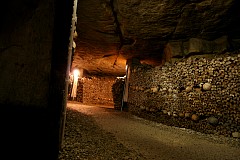
An ossuary, also referred to as a bone house, is a facility for the storage of human bones.
I had seen pictures of the Paris catacombs on the Internet. I asked the young employees
at the entrance why there didn't seem to be enough skulls to match the number of large
stacked bones like femurs. The answer is that small bones like fingers, vertebrae, etc.
along with bones that don't stack well like ribs and pelvises are first placed against
the walls and then the bones that stack well like femurs are used to contain the other
bones. Skulls don't stack nicely. They are incorporated in the bone "walls" for
shock value, but most are walled in by the femurs.
|
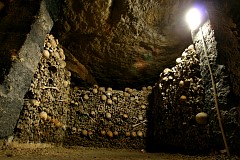
The only way I could make these pictures was to set the camera on the chairs that the guards
sit on and set the camera on exposure priority. From 1785 to 1786, in 15 months, millions of
bones and rotting corpses were transported from
the unsanitary city cemetery in Les Halles to this place. It was a monumental project to
transport the bones in huge carts at night across the city. I can't figure out how
they handled the rotting corpses - perhaps they were walled in using bones from
fully decomposed bodies.
|
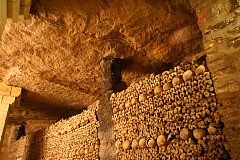
I remember walking past a sign that memorialized bones of the Paris mob killed by
the King's Swiss Guards while storming the Tuileries Palace
on August 10, 1792. The surviving Swiss Guards were
massacred while the royal family fled through the Tuileries gardens and took refuge
with the Legislative Assembly. Some skulls had what looked like bullet holes in them.
|
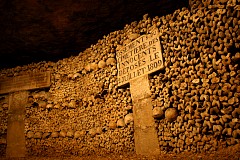
"Bones from the cemetery of the Innocents placed July 2 1809."
|
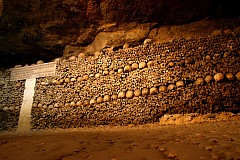
Venez gens du monde venez dans ces demeures silencieuses et
votre âme alors tranquille sera frappée de la voix
qui s'élève de leur intérieur: «C'est ici que le plus grand des
maîtres, le Tombéau, tient son école de vérité.» Tomb. de Hervey
"Come people of the world, come to these silent
homes (living spaces) and your tranquil soul will be struck by the
voice that rises from the interior. (from inside) It is here that the most
well known of the grand masters, the Tomb, holds (keeps) its school of
truth." - Thanks to Susan Browne
|
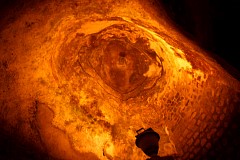
The underground tunnels and chambers of the catacombs have long posed safety problems for
construction in Paris.
The old tunnels sometimes cave in, occasionally resulting in a hole in the ground above and causing
damage to buildings. To prevent this, the IGC, Inspection générale des Carrières (General
Inspection of the Quarries) was established in 1777 by the government in order to monitor
the current quarries and prohibit the digging of new quarries. Here in the ceiling is
a repaired cave-in.
|
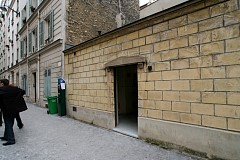
Here is the unassuming exit from the catacombs.
|